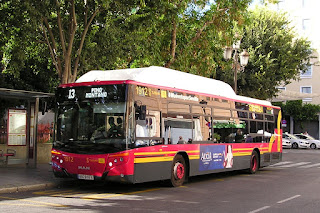Arriva BT66 MTU. Volvo B5LH with Wright H45/21F body.
During
November 2019, the City of Liverpool held a city wide Son et lumière as a way
of brushing off the early winter blues.
At my age,
I no longer need "A ticket to Ride" just a bus pass and "With a
little help from my friends", who keep an up-to-date set of timetables, I
can get “Here,
There, and Everywhere” or in this case Stagecoach Gold service 417, so I stand
at the bus stop in the hope it “Don’t Let Me Down”. The comfortable Scania/Alexander
Dennis E40D with coach seats makes the journey on “The Long and Winding Road” a
pleasure and there is no need for me to “Drive My Car”.
Arriva SL64 JHU. Alexander Dennis E40D H47/31F.
“Do You Want to Know a Secret” - Liverpool has the finest architecture
of any city in Britain. It is an excellent choice for any "Day Tripper”
regardless of the weather, and today it is mainly rain although at one point I
did think “Here Comes the Sun” which is problematic for photographs at this
time of year with so many tall buildings. When it comes to bus hunting, the
various city centre termini are well spread out and require some forward planning
to prevent excessive walking but “We Can Work It Out” and it's “Getting Better”
all of the time. The good news is that a new traffic management system is
planned which should reduce on-street terminals and make more use of Liverpool
One (Paradise Street) bus station thereby reducing the chaos in Queens Square.
Starting my tour at one of the highest points in the city centre,
opposite Lime Street Station, I'm the only "Fool on the Hill" as
gentle rain adds to the gloom, but traffic is slow outside the Liverpool Empire
so buses "Don't pass me by" as they queue where bus lanes once kept
things moving. Around the corner at the top of Queens Square, the endless
stream of buses is held at traffic lights giving the Radio City Tower a chance
to shine in the background. Continuing down the hill, the junction of Queens Square
Arriva SL64 JFK. Alexander Dennis E40D H47/31F.
In daylight, the Liver Building and a new black, glassed building
opposite provide excellent focal points for photographs of buses terminating
here. Tonight, it is the light show on the buildings that are the main
attraction and "You’ll never walk alone" as the crowds sweep us along
towards the rejuvenated Albert Dock, past a Routemaster, American school bus
and fake steam bus all now acting as food outlets. The “Magical Mystery Tour” bus stop has a Setra in full psychedelic
livery awaiting sightseers and is close to a walk through the time tunnel; sadly
just a tunnel of white lights that tonight only transport you as far as
Liverpool One Bus Station which is now devoid of Arriva's full electric BYDs - no
doubt lacking sufficient charge after a full day’s work to continue through the
evening with all lights blazing.
Arriva SL64 JDO. Alexander Dennis E40D H47/31R.
It has been a long day, “I’m So Tired” it must be time to “Get Back” to
Cooks Street, the starting point for all tunnel buses until 9pm when they start
short working from Sir Thomas Street, don't
“Ask Me Why”. All tunnel buses are provided by Arriva apart from routes
471/472 which are joint services with Stagecoach under a Merseyside PTE quality
contract. Tonight Stagecoach Gold will provide my "Ferry cross the
Mersey" and “When I Get Home” it will be time for a nice cup of tea.
With the weather as it was, "Something" tells me I should have
been here "Yesterday" because it was a “Good Day Sunshine”.
I recon that's 25
to the Beatles and 2 to Gerry and the Pacemakers.
Halton DK03 TNL. Dennis Dart SLF with East Lancs B43F body.
Heading home Stagecoach buses departing Liverpool city centre.














